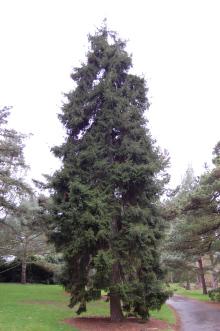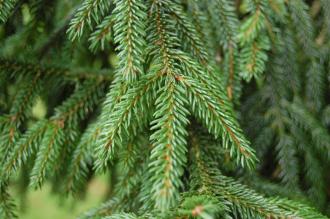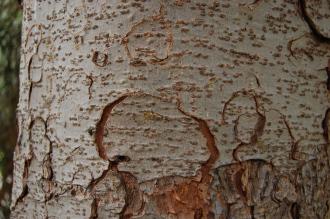
Picea orientalis ‘Aurea’ (09/02/2013, Kew Gardens, London)
Position: Full sun
Flowering period: Summer
Soil: Moist, well drained
Eventual Height: 30m
Eventual Spread: 10m
Hardiness: 4b – 9a
Family: Pinaceae
Picea orientalis ‘Aurea’ is a is a slow growing, evergreen coniferous tree with a narrow pyramidal habit. Its dark green leaves are needle like and up to 1cm long. In spring its new leaves appear gold in color for about six weeks. Its trunk may achieve a diameter of up to 1.5m. Its branches are slightly drooping. Its light brown bark is smooth, becoming fissured with age. Its red/ purple flowers are in the form of pollen cones and female cones. Its fruit are pendulous cones and when mature are mid brown up to 9cm long and 1.5cm broad.
The species Picea orientalis, commonly known as the Caucasian Spruce or Oriental Spruce, is native to the Caucasus and north east Turkey.

Picea orientalis ‘Aurea’ Leaf (09/02/2013, Kew Gardens, London)
The etymological root of the binomial name Picea is derived from the Lain Pix meaning ‘pitch or tar’ in reference to the Spruce trees resin. Orientalis is from the Latin meaning ‘from the East: Orient’. Aurea is from the Latin meaning ‘golden’ in reference to its spring leaves.
The landscape architect may find Picea orientalis ‘Aurea’ useful as an attractive parkland tree. It should be located away from cold drying winds.
Ecologically, Picea orientalis ‘Aurea’ seeds may be attractive to some birds and mammals.
The Royal Horticultural Society has given Picea orientalis ‘Aurea’ their prestigious Award of Garden Merit in 1993.

Picea orientalis ‘Aurea’ Bark (09/02/2013, Kew Gardens, London)
Picea orientalis ‘Aurea’ prefers moist, fertile, well-drained soils. It tolerates most pH of soil, although it prefers acid to neutral soils. It will tolerate soils of poor fertility.
Picea orientalis ‘Aurea’ requires little maintenance.

